The special project implemented is Groups at the Inpatient Program at Parkridge Valley. This is a short term facility focused on crisis stabilization and the average stay of patients are about 3-5 days. The groups done are based on a short-term stay and can be utilized weekly in the same manner. I made a program which utilized 7 group sessions per week (one per day) in addition to the two daily goal groups already apart of the program in the morning and in the evening. The number of patients in a group ranged anywhere from 2-14.
Social Issue
The social issue being addressed is within the consistency of groups being done and how important it is to address managing emotions and forming positive and health relationships and boundaries for short-term and long-term use. These individuals face the challenges of homelessness and mental health issues. Some of these include but not limited toe: depression, anxiety, and substance abuse. These individuals have a hard time being able to manage negative emotions, stress, and situations which can lead to these individuals being admitted to an inpatient program at Parkridge Valley. I sent a needs assessment to the patients/participants in the program and I have also interviewed mental health technicians and social workers at Parkridge Valley on the current needs of the inpatient group program. All have stated that this is a social issue that needs to be addressed. There is a lack of consistency in the execution of groups and the need for consistency is much needed for the patients, as well as teaching these individuals emotional regulation skills that can equip them to handle situations, individuals, and emotions better in the future.
The negative implications include negative emotions that comes with homelessness, mental health, and substance abuse. The negative implications are surrounding the cycle of which these individuals face these problems.
The individuals affected are, the patients coming in for crisis stabilization in at Parkridge Valley. They are adults and seniors over the age 18+.
Interventions
The mission of the current program is to provide individuals with mental health issues crisis stabilization and rehabilitation. However, there is no consistent use of groups in the program. Therefore, the mission is to enhance the current program and establish some understanding of the importance of consistent use of groups and educating individuals on the importance of emotional regulation skills and how this can help manage stress, depression, anxiety, and many other problems. The goal is to provide patients and clients with consistency in conducting groups and more specifically, emotional regulation strategy groups. By providing clients with consistent groups and emotional regulation, the participants develop coping skills, learn healthy boundaries, learn how to practice mindfulness, and learn how to process their feelings, emotions, and reactions. These skills teach them to become more self-sufficient, positive, and create a routine for their life out of the inpatient program.
The intervention tools used is an enhanced inpatient group program focused on emotional regulation. These groups consist of mindfulness, coping skills, healthy boundaries, music therapy, process groups, self-care, and positive self-talk.
The theoretical framework used for the groups included systems theory, person-in-environment, cognitive model, trauma informed care, and the Transtheoretical Model of Change.
The systems theory is based on an idea that behavior is influenced by a variety of factors and those factors work together as a system (Adams, 2012). These factors can include family, friends, environment, economic class, and the environment at home. The person in environment theory states that a person is heavily influenced by their environment; and their problems and issues can be largely understood by environmental influences (Tyler, 2021).
The cognitive model theory asserts that people’s perceptions of situations influence their emotional and behavioral reaction (Asegur, 2020). Trauma informed care recognizes the presence of trauma symptoms and acknowledges the role trauma may play in an individual’s life (Vines, 2020). The Transtheoretical Model of Change states that changing a behavior is not a coincidence, however it is more of a process. Each individual is in a different stage of change. People pass through different stages which include: precontemplation, contemplation, preparation, action, and maintenance (Hashemzadeh, Zare-Farashbandi, Alavi-Naeini, & Daei, 2019).
These models are used and helpful to transition from inpatient care to being in the the outside world. It is important that these individuals learn short-term and long-term skills that will help them with coping, stress, and hopefully diminishing the cycle. It will create a more stable environment and more consistent life. I used all of these frameworks because they all play an important role in mental health and the individual. It helps them understand and get a deeper understanding of themselves as a whole. It also shows how environment, situations, and different people can influence their thoughts, behaviors, emotions, feelings, and circumstances. This also helps individuals understand how all of these things contribute to difficulty with emotional regulation.
Emotional skills are strongly related too many parts of our life which includes social and environmental situations. Kraiss et al.(2020) states that their is importance in emotion regulation to helping alleviating mental health issue symptoms and improving well-being in individuals and in patients with mental health disorders. Therefore consistency and improvement of emotional regulation is important to be a part of the curriculum, specifically for these individuals that come in with mental health issues and in need for crisis stabilization.
Results
Completed one week worth of the consistent use of emotion regulation group therapy within the inpatient program at Parkridge Valley. There was a total of four groups done per day. Those who participated received one group per day in addition to the other three groups that are done by the social worker and recreational therapists. There are about 14 patients per four units that can receive these additional groups and consistency. The results of the needs assessment within staff members was that there was no consistency within groups and many individuals did not have a guideline or ideas on how to execute groups.
The results of the pre test among patients were that there was a lack of consistency in the execution of groups and that there were a need of specific groups that they found most beneficial to their care, which fell under emotional regulation. The results of the post test were that having consistency within the group inpatient program benefited their treatment and helped members be equipped with skills that could better assist their mental health upon discharge. There was a positive impact of these emotional regulation groups by increasing well-belling and decreasing symptoms of stress, anxiety, depression and any other mental health issues that were present at admission. Individuals stated to have gained skills and strategies that will help them with emotional regulation short and long term upon leaving the hospital.
There were no recognitions or rewards for this project.
Conclusions
I was able to collaborate with the Director at Parkridge Valley, mental health technicians, a few social workers at Parkridge Valley, and the patients. I was able to gather data from them in regards to the current need for the inpatient program at Parkridge Valley. I was able to conclude that an enhancement and consistent administration of groups was much needed. I was able to gather input on what kinds of groups would be the most beneficial to the patients and what is needed based on the data. The feedback received all point to the lack of consistency and lack of groups that had to do with learning emotional regulation strategies and/or skills. Therefore, the focus was on emotional regulation because patients and staff members stated to be the most beneficial. The groups conducted were: learning about healthy boundaries/healthy relationships, mindfulness, self-care, music, positive self-talk, journaling, goals, and coping.
The results of the pre test were that there was a lack of consistency in the execution of groups and that there was a need of specific groups that all fell under emotional regulation. The results of the post test were that having consistency within the group inpatient program benefited their treatment and helped members be equipped with skills that could better assist their mental health upon discharge. There was a positive impact of these groups by increasing well-belling and decreasing symptoms of stress, anxiety, depression and any other mental health issues that were present at admission.
Limitations
The current limitations included how much time was to implement the project. This facility is a short term facility and patients are being admitted and discharged quite frequently. Therefore, the results were only able to be evaluated over the course of a day and at most over the course of a week. This creates a limitation because patients are not able to evaluate over the course of months. Another limitation was that many other individuals meant to facilitate the groups had no prior knowledge on facilitating groups, this created a big obstacle not only in this project, but as Parkridge Valley as a whole.
Another limitation was also having extra time to incorporate this program while also doing other tasks that had to be done while at my placement at Parkridge Valley. COVID-19 also created some challenge. The units were not able to do things together as much as they used to and it created difficulty with time. Lastly, there is just one of me so I was not able to evaluate all four units due to this. The staff is in the process of being educated on the groups I have made and this will then be able to be done accordingly in all four units.
Another limitation was staff shortages. This created a lack of consistency.
What I would do differently is that I would have created the groups in the beginning of the process and have the training be in the beginning of the process so that way the staff is able to help in the process and all four units would be able to be reached by now. As of right now, this will be done in the following weeks.
Nine Social Work Competencies
Competency 1: Ethics and Professionalism
- I will demonstrate ethical and professional verbal and nonverbal communication with the participants, stakeholders, developers, and staff of the program. I will also use technology ethically in order to create, implement, and evaluate the special project.
Competency 2: Diversity
- All participants had equal access to the services offered. I provided group session services to a population that may not have access to these services otherwise. The curriculum made is serving a big community that is in need of these resources.
Competency 3: Human Rights, social, Economic, and Environmental Justice
- I advocated for consistency among groups through the 7 sessions I have provided by communicating to community leaders about the issue of mental health and consistent groups. I have been able to talk to the director and she has accepted to use my booklet and resources for the inpatient program at Parkridge Valley.
Competency 4: Practice Informed Research and Research-Informed Practice
- I was able to do research on the effectiveness and importance of consistency of groups in the current inpatient program. All participants completed a pre and post survey related to the program.
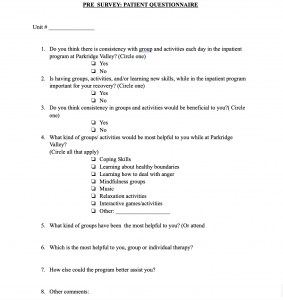
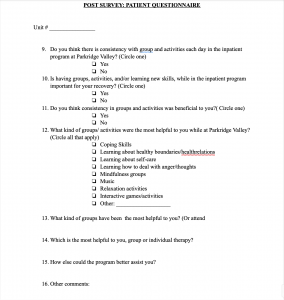
Competency 5: Policy Practice
- With the guidance of Parkridge Valley and their policies and procedures, I adapted the enhancement of the program with regards to those policies and procedures. In result this benefits the program.
- Confidentiality is addressed in these groups sessions, which follows the guidelines along HIPPA at Parkridge Valley. This also helps patients gain rapport with individuals leading the sessions.
- I used this infographic to educate staff and share with stakeholders like the Director about the enhancement of the inpatient group program.
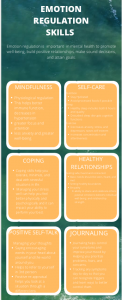
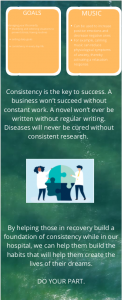
Competency 6: Engagement
- The use of group therapy and activities were used on participants in the program to ensure long-term benefits of skills and techniques among the mental health population at Parkridge Valley. Interviewing clients to determine the strengths and challenges of the current inpatient group program at Parkridge Valley will be discussed to better assist the patients in the program.
- Here is the groups and activities used
Competency 7: Assessment
- I created a small version of a needs assessment in order to identify a need at the current inpatient program at Parkridge Valley and how it is important to have consistency within groups for the benefit of the participants/patients of the program.
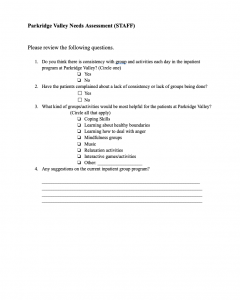
Competency 8: Intervention
- I created an one week group curriculum to ensure the consistency of groups done at Parkridge Valley. This will be in addition to the two morning and evening goal groups that will be conducted and also part of the emotional regulation skills curriculum. Since Parkridge Valley is a short-term facility, most individuals stay in the hospital 3-5 days. Therefore, this curriculum can be re-used as needed.
Competency 9: Evaluation
- The pre survey discussed in competency 4 was used for research to evaluate the current program put into place. Upon completion of the consistency among group sessions and enhancement of the current program, this evaluation was given to all patients.
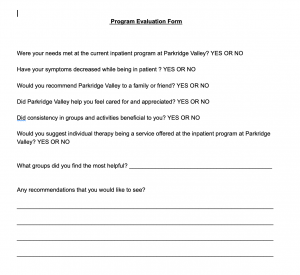
Sources
Adams, K. (2012) Systems Theory: A formal construct for understanding systems. Retrieved from: https://www.researchgate.net/publication/264818391_Systems_theory_A_formal_construct_for_understanding_systems
Asegur, E. (2020). Cognitive model: Theory OF Psychopathology: Beck Institute. Retrieve from https://beckinstitute.org/cognitive-model/
Hashemzadeh, M., Rahimi, A., Zare-Farashbandi, F., Alavi-Naeini, A. M., & Daei, A. (2019). Transtheoretical Model of Health Behavioral Change: A Systematic Review. Iranian journal of nursing and midwifery research, 24(2), 83–90. https://doi.org/10.4103/ijnmr.IJNMR_94_17
Kraiss, J., Klooster, P., Moskowitz, J., & Bohlmejer, E. (2020) The relationship between emotion regulation and well-being in patients with mental disorders.
Tyler, S. (2021). The person in environment. Retrieved from https://uark.pressbooks.pub/hbse1/part/main-body/
Vines, L. (2020). What is Trauma-Informed Care? Retrieved from http://socialwork.buffalo.edu/social-research/institutes-centers/institute-on-trauma-and-trauma-informed-care/what-is-trauma-informed-care.html


